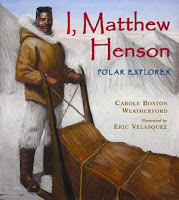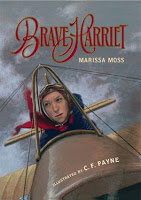Welcome to part one of my new thread on nonfiction and historical fiction picture books. Today, let’s take a look at some “biographies” told through first person
point-of-view (POV). I know what you’re thinking. Wouldn’t a first person
biography actually be an autobiography? Well, welcome to the world of
picture books where good storytelling often trumps general rules of nonfiction
literature. These are all well researched, compelling, lovely books worth paying attention to, but note that, by writing in first person, the author/narrator has stepped into the shoes and voice of their subject. An interesting approach, wouldn’t you say?
Note, also, that many such titles lack a disclaimer about fictionalized elements. I leave it to you to debate the fiction vs. historical fiction question amongst yourselves. The purpose of this thread is merely to share my observations about creative devices and approaches authors use to introduce history to young readers. I hope you’ll find it enlightening and empowering.
You might be interested, especially in future posts, by the Library of Congress classifications which may not always align with our own definitions of fiction vs. nonfiction. Note that libraries make their shelving decisions based on that LOC catalog-in-publication classification.
First, a quick disclaimer: These particular titles have been selected merely as a sampling from my personal readings, often limited by library inventory availability. This is by no means an exhaustive list.
Piano Starts Here: The Young Art Tatum by Robert Andrew Parker (Schwarts & Wade, 2008)
Art Tatum was plagued by near-blindness from the time he was a child, yet he became a revered pianist who made his mark on the musical world.
Excerpt from an early page of text: “Still, bad eyes can’t keep me
from playing the piano. My hands get to know the keys, the short black
ones on top and long white ones below.”
*Shelved in the nonfiction section of my local library.
*The copyright page indicates this as Jazz musicians- Biography.
*First person POV- not autobiographical
*Present tense. Chronological from childhood to mid adulthood.
*Back Matter includes: Author’s note, Bibliography.
I, Matthew Henson: Polar Explorer by Carole Boston Weatherford (Walker, 2008)
from the jacket flap: Matthew Henson was not meant to lead an ordinary life. His dreams had sails. They took him from the port of Baltimore, around the world, and north to the pole.
As a side note, the story is told in a couplet style, throughout.
 Excerpt from a pivotal page: “I did not sail north with Peary again and again through the frozen sea, charting the ice cap, inching toward the Pole, where no man had stood, for frostbite to halt our mission. When ice took most of Peary’s toes, I carried him back alive-Kokoya on our heels, howling in the wind.”
Excerpt from a pivotal page: “I did not sail north with Peary again and again through the frozen sea, charting the ice cap, inching toward the Pole, where no man had stood, for frostbite to halt our mission. When ice took most of Peary’s toes, I carried him back alive-Kokoya on our heels, howling in the wind.”
*Shelved in the nonfiction section of my library
*Copyright page indicates African American explorers- Biography
*First person POV- not autobiographical
*Past tense- chronological from age thirteen until he planted a flag at the North Pole
*Back Matter includes: Author’s Note
Abe Lincoln Remembers by Ann Turner (Harper Collins, 2003)
Abe Lincoln recounts his own life story, beginning with his humble childhood, through the various jobs he held as an adult, and through his study of law that eventually led him to the presidency.
 Excerpt from first page. “When I was little, the cabin we lived in was small with one room and one window. At first, I thought the sky was square like a piece of cut cloth. I could only see two birds in the sky and one squirrel in the tree.”
Excerpt from first page. “When I was little, the cabin we lived in was small with one room and one window. At first, I thought the sky was square like a piece of cut cloth. I could only see two birds in the sky and one squirrel in the tree.”
*Shelved in the nonfiction section of my library
*Copyright page classifies it as Biography
*First person POV- not autobiographical
*Past tense- chronological from childhood through the end of the Civil War, ending as the Lincolns prepare for a night at Ford’s Theatre.
*Back Matter includes brief author’s note. Author plainly states that, though based on historical facts, this is a work of fiction.
Black Elk’s Vision: A Lakota Story by S.D. Nelson (Abrams, 2010)
 Told with first person point of view as the medicine man brings to life what it was like to be Native
Told with first person point of view as the medicine man brings to life what it was like to be Native
American in the mid-to-late nineteenth century and early twentieth
century. The Native people found their land overrun by the
Wha-shi-choos, or White Man, the buffalo slaughtered for sport and to
purposely eliminate their main food source, and their people gathered
onto reservations. Through it all, Black Elk clung to his childhood
visions that planted the seeds to help his people—and all
people—understand their place in the circle of life.
 Brave Harriet: The First Woman to Fly the English Channel by Marissa Moss
On a clear morning in 1912, Harriet Quimby had a vision--she would
become the first woman to fly solo across the English Channel. If she
were to veer off course by even five miles, she could end up in the
North Sea, never to be heard from again. But she took the risk, anyway.
Except from first page:
“I hadn’t grown up wishing to be a pilot, because there were
no planes when I was a girl, but once I saw one, I knew where I belonged-
there, at the controls, with blue sky all around me. The day I saw my first
plane was the same day I started flying lessons, eager for my chance to be
alone in my own great bird.”
Brave Harriet: The First Woman to Fly the English Channel by Marissa Moss
On a clear morning in 1912, Harriet Quimby had a vision--she would
become the first woman to fly solo across the English Channel. If she
were to veer off course by even five miles, she could end up in the
North Sea, never to be heard from again. But she took the risk, anyway.
Except from first page:
“I hadn’t grown up wishing to be a pilot, because there were
no planes when I was a girl, but once I saw one, I knew where I belonged-
there, at the controls, with blue sky all around me. The day I saw my first
plane was the same day I started flying lessons, eager for my chance to be
alone in my own great bird.”



I recently read I, GALILEO by Bonnie Christensen. It's another good one to add to your list. This kind of thing will always bother me, but GALILEO is well-done.
Excellent! Thanks for adding to the list, Laurie. As someone mentioned on the NFYahoo listserv, this approach is a slippery slope. But it seems to be working so we need to keep open writerly minds.
Do you know of chapter books written this same way? I’ve been trying to think of some.
Thank you for sharing this picture book biographies in the first person. I look forward to reading all of them.
Thanks for this blog. It came up in my search and was helpful.